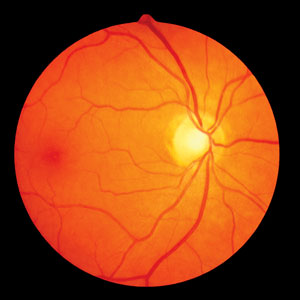Jan. 13, 2012 Research Highlight Biology
Keeping an eye on the Japanese genome
A particular type of age-related macular degeneration in the Japanese population is linked to four regions of the genome
 Figure 1: A photograph of a healthy eye. AMD-affected eyes have dark spots that lead to severe visual impairment in the elderly of developed countries. © 2012 iStockphoto / olaaf
Figure 1: A photograph of a healthy eye. AMD-affected eyes have dark spots that lead to severe visual impairment in the elderly of developed countries. © 2012 iStockphoto / olaaf
Age-related macular degeneration (AMD) is a common disease that can result in blindness. It is caused by cell death in the eye’s retina, which is partly responsible for transforming visual stimuli into electrical signals to the brain. Asian populations tend to exhibit a particular type of the disease, called exudative AMD, which includes changes in the blood vessels of the eye. Caucasians, however, tend to exhibit AMD without these vascular abnormalities. Now, a research team led by Michiaki Kubo at the RIKEN Center for Genomic Medicine in Yokohama has identified four genomic areas that increase the risk for exudative AMD in Japanese individuals1.
The researchers searched for genomic regions linked to exudative AMD by investigating single-nucleotide changes in the human genome. They compared the frequencies of 500,000 single-nucleotide changes between individuals with exudative AMD and normal, or control (Fig. 1), individuals. Other research groups had previously performed this kind of genome-wide association study (GWAS) in Caucasian populations, but not in the Japanese.
Kubo and colleagues began by performing a GWAS on 800 Japanese individuals with exudative AMD and 3,000 Japanese controls; they identified two genomic regions previously linked to AMD in Caucasians. This suggested to the researchers that the mechanisms underlying AMD in both populations are likely to be similar.
In a ‘replication study’ using 700 patients and 15,000 controls, the researchers then carefully examined 77 additional genomic areas that showed potential as candidate exudative AMD-associated regions in their initial GWAS. The replication study yielded two additional genomic regions that were linked to exudative AMD. One of these—on chromosome 4—covered four nearby genes, so the researchers were unable to pinpoint with certainty which of the genes were responsible for the disease risk. However, another region—on chromosome 8—was linked to the gene called TNFRSF10A, which encodes a receptor expressed in the eye that modulates inflammation and cell death.
The variant of the gene that Kubo and colleagues linked to exudative AMD seemed to regulate the expression of the receptor. “We are next planning to investigate exactly how the signaling pathway initiated by this receptor would affect the development of exudative AMD,” explain Kubo and Satoshi Arakawa, the study’s first author.
The identification of these genomic regions that are linked to exudative AMD could aid in the development of new therapies. “Our results will also help in the construction of risk prediction models for exudative AMD,” say Kubo and Arakawa.
References
- 1. Arakawa, S., Takahashi, A., Ashikawa, K., Hosono, N., Aoi, T., Yasuda, M., Oshima, Y., Yoshida, S., Enaida, H., Tsuchihashi, T., et al. Genome-wide association study identifies two susceptibility loci for exudative age-related macular degeneration in the Japanese population. Nature Genetics 43, 1001–1004 (2011). doi: 10.1038/ng.938
